UAA’s 2019 ConocoPhillips Arctic Science and Engineering Endowment awardees make important strides in Arctic research
Dec. 18, 2018
 |
|
From left to right, Thomas Folan, Gennady Gienko, Kurt Meehleis and Rob Lang discuss
their project to update Alaska's long-outdated snow load data and maps. The project
was one of four proposals selected for 2016 ConocoPhillips Arctic Science and Engineering
Endowment awards. (Photo by James Evans / University of Alaska Anchorage)
|
ANCHORAGE, Alaska — Faculty and students at the University of Alaska Anchorage are researching some of the Arctic’s most pressing issues, from how climate change is affecting Alaska’s buildings and infrastructure to how increasing solar penetration is affecting power system stability for Arctic communities. Funded by the ConocoPhillips Arctic Science and Engineering Endowment, the 2019 awards for these exploratory research projects total more than $470,000.
“UAA faculty and students live and work in the only Arctic state in the U.S.,” UAA Chancellor Cathy Sandeen said. “ConocoPhillips’ generous gift provides continuous support to conduct critical research in this important region.”
Selected projects must promote and grow the fields of Arctic science and engineering, demonstrate a likelihood of major scientific or engineering impact and strongly connect to community and industry. Programs, research and activities inclusive of Alaska students, communities, projects and opportunities are given priority.
Created in 2008 with a $15 million gift from ConocoPhillips Alaska, the endowment provides annual support to Arctic science and engineering programs and research at UAA and is the largest endowment in the University of Alaska system.
The winning projects for fiscal year 2019 include:
Improving cooling performance of battery backup facilities (Getu Hailu, principal investigator)
Cellphone towers and antennas in remote areas depend on battery backup systems to
provide uninterrupted service to users, especially in emergency situations. To avoid
degradation of the batteries’ performance, facilities must maintain an ideal temperature
range. This project aims to develop a simple, cost-effective strategy for cooling
battery backup facilities.
Combustion and dispersion model of particulate matter from in situ oil burning (Jifeng Peng, principal investigator)
In situ burning is a widely used method in onshore and offshore oil spill cleanup.
First responders nationwide lack the tools to accurately model particulate matter
dispersion patterns associated with in situ oil burning, which limits its use. This
project aims to develop a modeling tool to predict dispersion in order to minimize
exposure to humans and the environment.
Determining interdependencies in critical Arctic networks (Sebastian Neumayer, principal investigator; Mohammad Heidari Kapourchali, co-principal
investigator)
Many remote villages in Alaska rely on infrastructure for power, communication and
other necessities. Geographical remoteness makes the reliability and resilience of
the networks that provide these village services essential. This project’s objective
is to model the interdependencies of critical networks in Alaska to ensure their reliability
and resilience.
Building a new "pipeline" of oil spill recovery research at UAA (Patrick Tomco, principal investigator; Khrystyne Duddleston, Aaron Dotson and Timothy
Bradner, co-principal investigators)
This project aims to develop new opportunities for oil spill research and outreach
at UAA to help shape a new integrated teaching, research and outreach platform. The
project will focus on conducting research to facilitate external funding opportunities,
enhancing undergraduate education, and fostering research collaborations between the
university and external partners.
Operating photovoltaics in Arctic environments: Potential threats to Alaskan power
systems (Mohammad Heidari Kapourchali, principal investigator; Ahmed AbuHussein and Matthew
Kupilik, co-principal investigators)
Increasing solar penetration in Alaska has the potential to impact power-system operation
for both grid-connected communities and rural diesel-based microgrids that use solar
energy. The proposal aims to identify potential risks of increasing solar penetration
of photovoltaics, the systems used to convert sunlight to electricity, to power system
stability and efficiency for Arctic communities. This study provides hands-on research
experience to undergraduate students.
Toward the prediction of climate change impact on the built infrastructures in Northern
Alaska (Caixia Wang, principal investigator; Z. Joey Yang, co-principal investigator)
In recent decades, the temperature across the Arctic has warmed at twice the rate
of the global average. Alaska’s built infrastructures are facing increasing challenges
posed by climate change. This project seeks to develop a prediction framework for
key engineering design parameters to assess climate warming’s damage to the built
infrastructure or to consider its impact when designing infrastructures.
Enhanced 3D seismic imaging and geologic modeling on Alaska’s North Slope (Shuvajit Bhattacharya, principal investigator; Jennifer Aschoff and Z. Joey Yang,
co-principal investigators)
Permafrost is a major challenge for oil and gas exploration in Arctic regions because
it interferes with seismic imaging. The project’s goal is to reconstruct high-resolution
3D seismic images in permafrost areas to better visualize the subsurface for geologic
modeling of shallow rock layers and hydrocarbon exploration on the North Slope of
Alaska.
UNIVERSITY OF ALASKA ANCHORAGE
The University of Alaska Anchorage is Alaska’s largest university, educating nearly
17,000 students annually. UAA’s mission is to discover and disseminate knowledge through
teaching, research, engagement and creative expression. Learn more at uaa.alaska.edu.
CONOCOPHILLIPS ALASKA
ConocoPhillips has been leading the search for energy in Alaska for more than 50 years
and is committed to being a good steward in communities where it operates. ConocoPhillips
has been a long-standing supporter of the University of Alaska and has contributed
more than $43 million to the university system, including its historic $15 million
contribution to UAA in 2008.
Media contact
Austin Osborne
Director of Public Relations
(907) 786-1296 office
alosborne@alaska.edu









